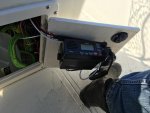Chum
Senior Member
I picked up a ‘new-to-me’ Sea Boss 19 Bay not to long ago and want to install a VHF radio on it. I’m not a complete stranger when it comes to wiring electronics, but this boat wiring has me stumped. I removed the switch panel hoping to find a breaker bar I could use to connect the radio, but instead it looks like all the wires get bundled up and drop down into the haul. Anyone have experience with this?






